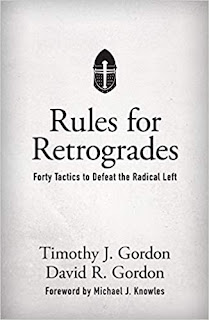Book Review: Rules for Retrogrades
Publisher: Tan Books
Pages: 151
Released: March, 2020
The Gordon brothers, Timothy and Dave, recently produced their first co-written book: Rules for Retrogrades. The book is titled after their YouTube show - a show discussing current and philosophical topics relating to Catholicism. Tim Gordon is especially known for his prior work with Taylor Marshall on the YouTube show nicknamed TNT.
To begin, I admit this book review is the most subjective one I’ve ever done. It is impossible for me to separate personal metacognition and temperament from the discussion. As an example, it should be noted that Rules for Retrogrades was the first book I ever read via a Kindle app. Rules for Retrogrades is also, most likely, the last book I ever read via a Kindle app. I did so to save $20. Never mind. Books should be held, written in, smelled. The experience of Kindle was impoverished, and a disservice to the work of the authors.
To the actual book.
What is a retrograde? Why does it matter? The brothers begin by offering the following: “A retrograde is a ‘deplorable 2.0’ – the thinking man’s version. A retrograde calculates, night and day, how to return to the Old World Order of moral and sexual decency, familial patriarchy, local rule and subsidiarity, […] and most importantly, the social kingship of Christ” (p. 10). In other words, true Catholics too often act like punching bags for the secular “culture”. The gist of this book is to incite Catholics to methodically counter punch. It is a call to training, and to action.
The book mimics Saul Alinsky’s Rules for Radicals, a thought process that has devilishly infected many prominent leaders such as Barack Obama, Hillary Clinton, and much of the Midwest Catholic Church. Written letters state that Pope Paul VI was also an admirer of Alinsky’s work (Marshall, Infiltration). Well Alinsky was successful in his workings, obviously by the devastation of thought existing in the Western world today. The Gordon brothers, thus, in this book seek a successful revival of sanity.
40 counteractive rules are given – in just 151 pages. Thus, the book is fast-paced. However – and it is here I turn to the subjective – the fast-paced flow is a significant flaw for me. One person I know reads books and wonders how the book will change him. A seemingly pragmatic approach, and effective if done appropriately. I, on the other hand, read a book for the book’s sake. I wrestle with ideas in my mind. I place the ideas against what I know, or thought I knew. It is a lengthy process. When it’s all finished, then, if the idea is compelling and demonstrative, it convinces me to act on it.
Rules for Retrogrades has 40 rules, but they are not fleshed-out in depth. I think of reading a work by Anthony Esolen. There are 8-10 chapters. Each chapter is a work of art, with examples, literature, and eloquence to influence the reading. By the end, one is provoked to think. Rules for Retrogrades is not this. It gives a quick rule, perhaps an example or two, and then moves on to the next rule. This is unconvincing to a reader such as myself. I am decidedly not impelled to act based on such a format. To be fair, what is said is by and large filled with insight, and even wisdom. It just does not ascertain to the necessary depth of understanding.
Some highlights from the book are that it is well-written (except for one criticism I have), and provides several money quotes from history. For example, in quoting General Patton, it says, “No one ever won a war by going out and dying for his country; he won it by making some other dumb bastard die for his country” (p. 18). I specifically liked rule 11 – “Never trust a man who is unwilling to have enemies” and rule 28 – “For radicals, the ‘issue’ is never the real issue.” I could list many others that were excellent reminders of the nefarious ideas we face as counter-cultural Catholics.
Some critiques I have are, again, that the chapters are too short, some rules are not overly convincing (i.e. boycotts are shams – rule 32), and that though the book is well written, often one needs a dictionary to understand several words in a sentence (a plus to reading with a Kindle, I suppose), yet at the same time the same sentences will use West-coast colloquial expressions. Either be eloquent, or not. Pick one. Finally, an undeniable difficulty with the book: I read it as an all-out Twitter battle was ensuing between Taylor Marshall and the Gordon brothers (topic was the SSPX, and all parties involved share some blame). It is hard to take seriously such rules as “Never, ever ‘frag’ a fellow retrograde.” It felt like taking my children to a circus-like Novus Ordo Mass, with irreverence and insanity, and telling them, “Look! Jesus is really present!” In other words, I would suggest a 41st rule: “practice what you preach.”
But lest I sound overly negative, the book is well worth a read. In fact, I will continue to listen to the Gordon brothers on YouTube, for it is there I hope they go into greater depth on their rules. Undoubtedly, we do need a well-thought-out fighting spirit. And the Gordons bring this. I commend them for their efforts. Whether or not they are convincing enough, this remains to be seen.







Comments
Post a Comment